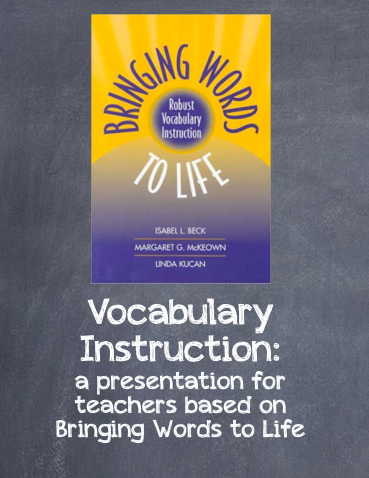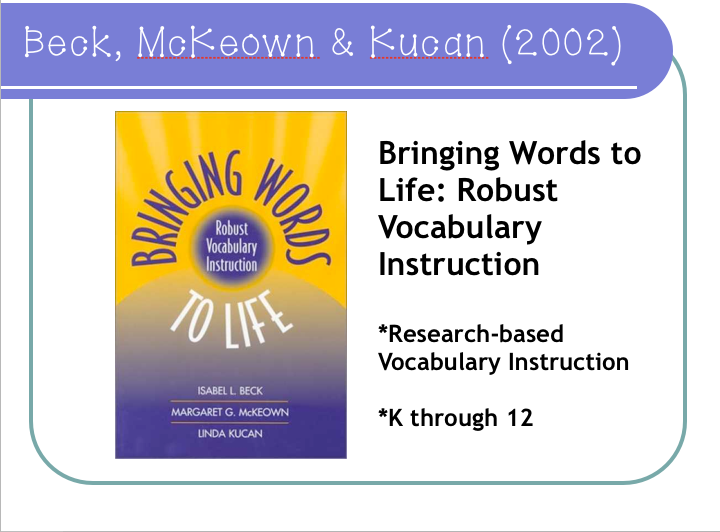And that's how Part 2 of my professional development presentation for our teachers came about:
I had just read an AWESOME book: Bringing Words to Life: Robust Vocabulary Instruction by Beck, McKeown, and Kuchan (2002), which has been referenced in TONS of academic and professional circles.
If you haven't checked this one out, you should! I came across it first in some of my online research. Then, one of my principals listed it as one of her favorite books in a staff e-mail. And at that point, I knew I had to have it and with a 1-click stop in my Amazon shop, the book quickly arrived on my doorstep. The book was also mentioned in one of my ASHA sessions last November in Atlanta. It's everywhere!
Bringing Words to Life was the basis for the following slides and talking points. So part 2, here we go!
A quick overview to start:
I highlighted the key points from my previous presentation on language impairment that were related to vocabulary.
Also included was some pretty
important research with some pretty big implications:
important research with some pretty big implications:
And then I talked about the relationship between vocabulary and reading comprehension, which is a big struggle for a lot of language-impaired kids.
My example was this:
Take this paragraph and pretend
you don't know the red underlined words...
...which would mean you're essentially reading this:
Now given that, can you answer main idea/detail or inference questions about it? Probably not.
Then I introduced Bringing Words to Life, which has practical suggestions for both 1) what to teach and 2) how to teach vocabulary.
The authors note that conventional wisdom teaches us that we learn vocabulary from context. Before entering school, kids learn from an oral context. Once kids get to school, there is a shift in focus to acquiring words from written text. There are several state and common core standards based on using context-clues to learn words.
The authors argue that oral language contexts are much more conducive to learning vocabulary because of the added intonation and meaning available. Using written text as the primary source for vocabulary acquisition becomes even more of an issue for struggling readers.
Even with good decoding skills, not every word meaning can be deduced based on the context.
See the below example:
...hard to tell the tone of that paragraph unless you already know what the word grudgingly means.
The authors introduce Tier 1, Tier 2, and Tier 3 words. Tier 2 words are the academic words that are especially important for reading comprehension.
The authors recommend the following:
When the authors write about student-friendly definitions, they say that longer definitions with lots of information are better for leaning and understanding words than some standard dictionary definitions.
For example, take a look at the word disrupt in the following example:
...words may be commonly misused if a standard dictionary definition doesn't capture the essence of the word. Student-friendly definitions are preferred!
At the end, I brought the information back to the classroom and encouraged teachers to 1) read the book if they were interested, and 2) have rich verbal environments in the classroom to benefit not just kids with a language impairment, but all kids!
Teachers can:
- Teach the kids to pay attention to new words
- Connect with words beyond just the classroom
- Use various dictionaries: unabridged, learner
- Use vocabulary words in morning meetings and on notes
- Have a word of the day
- Use crosswords and scrabble games to make vocabulary fun and exciting
...teach kids to love words! What ways do you create rich-verbal environments in your speech and language rooms? What ways do you see teachers doing this in the classrooms? I'm curious!
And so ends my PD Presentation Part 2. My principal has already requested a part 3 presentation on a new topic for next year, so stay tuned!
Thanks for stopping by!
Mrs. Ludwig
p.s. As I've written this, I just found a post that was written by Jenn over at Crazy Speech World about how she collaborated with a teacher to create student-friendly definitions based on Beck, McKeown, & Kucan's work. Love it! Check it out HERE! :)




























